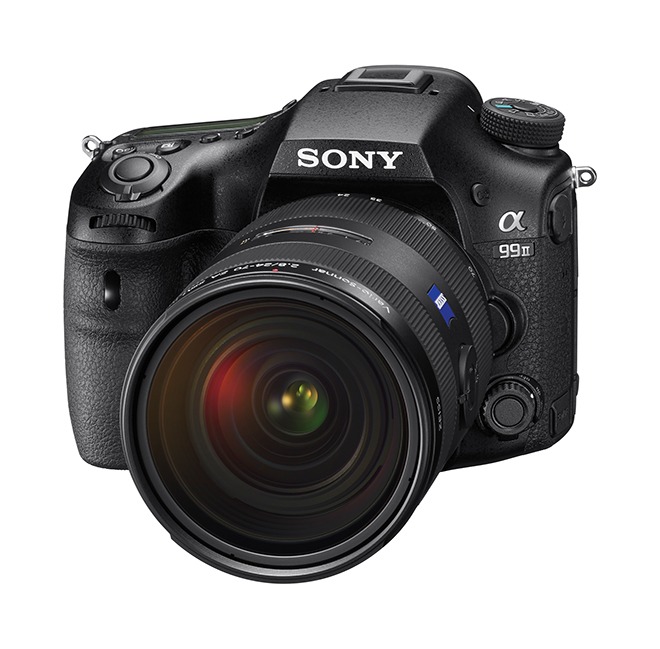Positioning itself somewhere between smaller mirrorless cameras and full-blown pro DSLRs, Sony’s A99 MkII represents the pinnacle of the company’s Single Lens Translucent range. Fergus Kennedy finds out how well it delivers in real-world situations.
Article originally published in Outdoor Photograph’s Autumn 2017 issue, OP222.
There’s no doubt that the A99 MkII boasts an impressive specification: a 42MP full-frame sensor is the headline feature, but it’s backed up by in-body image stabilisation, 12fps continuous shooting and 4K video. However, the real magic comes from the A99 MkII’s viewing system, which combines both a mirror and an electronic viewfinder. The idea is that the semi-transparent mirror directs some light to a dedicated AF sensor, and the rest through to the imaging sensor (which also has AF sensors). This results in a Hybrid Phase Detection AF system that can utilise 79 AF points on the dedicated AF sensor for precision focusing and 399 AF points on the imaging sensor for wide coverage. Unlike a traditional DSLR, the mirror does not flip up when the shutter is pressed, enabling a continuous view of the subject.
Although the electronic viewfinder (EVF) will inevitably divide opinion, it does have its advantages. The greatest benefit is being able to see in ‘real time’ the effect of changes you make to the settings, so you can see the exposure, white balance and so on before you make an exposure. You can also review images without taking your eye from the viewfinder. However, there is arguably something a little bit underwhelming about the electronic view of a scene through the EVF, although this is a highly subjective point.

Image above: The Sony A99 MkII handles low-light conditions well.
Sony A99 MkII with 24-70mm f/2.8 ZA SSM lens at 60mm, ISO 200, 1/200sec at f/2.8
Ergonomically, the A99 MkII is easy to get along with. The body is considerably larger than its full-frame mirrorless stablemates (including the 42MP A7R MkII), which aligns it more closely with full-frame DSLRs. Most of the controls are easy to access and understand – even for those new to the system – although the unconventional position of the AF controller button and dial on the front of the camera may take a little time to get used to.
Once on the computer screen, the images from the A99 MkII look beautiful; the 42MP files exhibit great dynamic range and there’s plenty of scope for pulling information from the shadows and reining in bright highlights. The level of detail is also phenomenal and would likely satisfy the most demanding pixel-peeper.
Of course, your lenses also need to make the grade if you want to get the best from the camera. Fortunately, Sony has a good range of zooms and primes in its A-mount line-up, and third-party manufacturers make some great additions, particularly Sigma’s premium Art range.
Although static subjects are easily dealt with, the A99 MkII’s hybrid AF system and impressive 12fps frame rate also promise a camera that will suit photographers who shoot fast-paced action, such as sport or wildlife. To put this to the test I asked a willing volunteer to run straight at the camera while I shot at the camera’s maximum burst rate, using continuous AF, the central focus point and an aperture of f/1.4 to ensure there was very little margin for error. Overall, the results were pretty good, although there were a few ‘misses’ where the focus fell just behind the subject, as if it was not quite keeping up with the movement.

Image above: Even at higher ISO settings, the Sony A99 Mk II produced rich, clean images.
Sony A99 MkII with 24-70mm f/2.8 ZA SSM lens at 24mm, ISO 400, 1/80sec at f/6.3
The hit rate improved when it came to photographing a bird in flight moving across the frame, though: tracking AF, an uncluttered background, the camera’s in-body image stabilisation and a slightly smaller aperture ensured consistently sharp results.
Sony hasn’t skimped on the video front with the A99 MkII, which sees great-looking, full-frame 4K video and 1080p HD video that can be recorded at up to 120fps (with no sensor crop) for fans of slow motion. The rear LCD articulates nicely, without interfering with the HDMI out, microphone and earphone sockets on the left side.
My only complaint is Sony’s decision to limit the AF to a maximum aperture setting of f/3.5 in Program mode; if you want to shoot at a wider aperture you need to switch to manual focus. I’m not sure why Sony would to do this, but it’s puzzling in an age where other cameras have very effective video AF without such limitations.
SPECIFICATIONS
Sensor Exmor R CMOS sensor (35.9x24mm) with 42.4 million effective pixels
Resolution 6000 x 4000 pixels
Recording formats (movie) XAVCS, AVCHD, MP4
Viewfinder 1.3cm (0.5in) EVF with 2.4 million pixels; 100% coverage
LCD 7.5cm (3in) tilting LCD
Lens mount Sony A-mount
AF system Hybrid Phase Detection AF
Shutter speeds 1/8000–30sec, Bulb
ISO range 100–25600 (50–102,400 extended)
Storage Dual SD card slots supporting SD, SDHC and SDXC memory cards
Power source Rechargeable lithium-ion battery NP FM500H
Dimensions 143 x 104 x 76 mm
Weight 849g (with battery/no lens)
LIKES
Articulating LCD
Image quality and resolution
Wide AF point spread
Blistering frame rate (12fps)
Video quality
In-body image stabilisation
DISLIKES
Restricted AF in video
No touchscreen
Battery life
VERDICT
Aside from the unusual AF issue when shooting video, the A99 MkII boasts a very high specification at a relatively competitive price. For landscape enthusiasts it has the ability to capture fine detail thanks to its full-frame, 42MP imaging chip, while wildlife enthusiasts will find the Hybrid Phase Detection AF system ensures more hits than misses. If you are happy using an EVF and don’t need the smaller size of Sony’s A9 or A7 range the A99 MkII definitely has a lot going for it.
RATINGS
Handling 90%
Performance 90%
Specification 95%
Value 93%
Overall 92%
Guide price £3,000 (body only)
sony.co.uk
The competition is now closed

